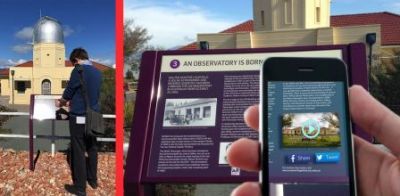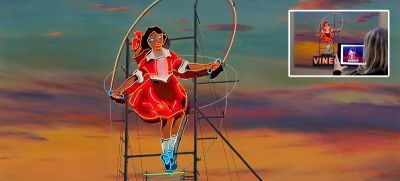
Canberra is home to a number of people across government, academia and business that are changing the way we think and understand the world.
We caught up with Amber Standley, whose business APositive is changing the way we experience advertising, digital content and interact with data.
How did you get started in business?
I started off with receiving a redundancy, and it was the best thing that could have happened to me.
I left through the front door and was invited back through the back door as a consultant in augmented reality – I was in a research group that was looking at augmented reality for education.
While I was in the research group, we were constantly being bombarded with requests for commercial applications; the more I looked at the technology I came to realise that it is the way of the future.
What is Augmented Reality?
Augmented reality is overlaying digital content in the real world, and then using your smart device whether a smart phone or Google Glass as a lens to see the extra layer. For instance, we overlay digital content in print. You look through your device at the printed images and they come to life whether as a 3D animation, video or interactive links in real time.
One of our projects with the ACT Government, AusIndustry and Lighthouse included filming a number of entrepreneurs as part of a digital exhibition; there was a physical component in the form of glowing spires, each with an interchangeable portrait, and the digital content attached to them using augmented reality. The user scans the portrait and a mini entrepreneur appears to be standing on top of the image sharing their secrets to success.

Another recent project was for ANU's Mount Stromlo Heritage Trail; using augmented reality, we took their heritage content to create a digital heritage trail. People visiting the area can scan signage to have access to video and audio content as they follow the trail. We're also looking into digitally re-building some of the heritage buildings lost in the 2003 bushfires through augmented reality.
We also worked with street artist E.L.K. and comedian Will Anderson to create a portrait of Will for the Archibald Prize and augment it with a video of a skit we filmed with him.
For Melbourne Art Fair, we took an oil painting by artist Jim Thalassoudis of Skipping Girl Melbourne sign where anyone who scanned the portrait will receive their own unique track of street sounds; turning it into a living portrait.
Where is the industry going?
Humans' ability to collect and generate data exceeds our ability to analyse it and share it. Augmented reality can provide the mechanism to help us understand big data and make it relevant.
I recently travelled to the United States for the World Augmented Reality Conference in Silicon Valley. They were running a Hackathon and I joined in, forming a team, we were given the challenge of coming up with augmented reality applications for wearables like Google Glass, Oculus Rift and to create the next big app. Our team created an application called 'Plucky' for the wearable 'SeeBright' (a kind of hybrid between Occulus and Google Glass). By looking through SeeBright the user can see an augmented reality interface and map of their location. Tiny coloured feathers with Twitter hashtags written on them appear on the map at the location they are tweeted in real time. The user can explore the hashtags by using their hands to 'Pluck' the feathers they are interested in and expand their content by adding them to a virtual 'scrapbook'. Incredibly we managed to win 3rd place which was really exciting.
Leading representatives in the industry believe that exploring social media data in a real time space is where augmented reality is heading for the future.
We will be using our hands and augmented reality will be the interface in which we engage with data. Two people will be able to see the same projection together, and it will make for a more social engagement with one another as opposed to looking down at our hand-held devices.
Society is still very reliant on our smart devices or smart phones, but once digital eyewear such as Google Glass and Oculus Rift becomes more fashionable and affordable, that will be one of the main ways we interact with data.
How can businesses use augmented reality?
Augmented reality delivers a new tool for marketers to leverage and to create something fun, immersive and above all, memorable. Augmented reality:
- is accessible to a majority of clients because the majority of people own smartphones
- helps brands or campaigns 'come to life' through client interaction
- provokes emotional responses through strong sensory experiences
- drives clients to take action (measureable ROI)
- spurs clients to share their experiences through social networks
- provides richer content capabilities
Augmented reality allows for extra nuggets of information to be added to printed collateral – the standard brochure can be enhanced by attaching 3D models of your products. Customers can interact with your product, move it around and examine it without having to be in store. It's even possible to create a AR event by hijacking a space digitally – you can use geolocations to place content like 3D interactive models and invite people to take part in the event by scanning the area using their smart device.

Is augmented reality just for big business?
We recently changed our business model to cater for both big business and small business. We can create custom Augmented Reality applications and experiences for bigger clients but we can host smaller clients digital content on our APositive app for a one time setup cost an a monthly subscription fee. That way if the client already has content or a preferred content supplier we can work with them to turn it into an AR experience.
The best thing about augmented reality is its level of engagement; when people first see it, it's the same reaction as seeing colour TV for the first time. It's about making things fun and having a reaction while also accessing amounts of information.
What should businesses considering augmented reality keep in mind?
When using augmented reality to change people's behaviour, it's particularly important not to make it a chore. Simplicity is best. It's about making the experience fun and engaging through interaction.
Content will always be key; don't use something that doesn't mean anything. Don't rely on augmented reality just for the "wow" factor. Make sure the information you deliver is useful and use the technology to only enhance the message.
It is important to make sure whatever you create maintains interest and the momentum continues as people access it over time.
Have you got any tips for someone wanting to start a business?
- Be prepared to do everything. When you're a startup, you are the janitor as well as the CEO.
- You will probably work harder than you have ever worked in your life. I'm one of those people who don't like being bored; because I enjoy what I do so much I don't seem to get overwhelmed by being busy.
- Everyone tells you to network and it's true. I've always been shy but in business, it's something you've just got to get over. Go to networking events and talk to people, no one enjoys the first awkward 10 mins but you will meet loads of interesting people. It's great for enhancing your businesses profile and finding new partners and opportunities.
- Keep up with new opportunities – there is so much out there, keep your eyes open for things and people that can help you.
About Lighthouse Business Innovation Centre
Lighthouse has a strong track record of supporting entrepreneurs, researchers and inventers on the path from concept to commercialisation. Since July 2008, Lighthouse has worked with over 990 distinct enterprises and provided group and peer based services to over 3400 enterprises and individuals. For over five years Lighthouse has successfully delivered business advice, education, mentorship and networking opportunities to help these businesses commercialise their ideas and grow their companies. Lighthouse also delivers programs such as the ACT Microcredit Program for the ACT Government. Visit www.lighthouseinnovation.com.au for more information.


